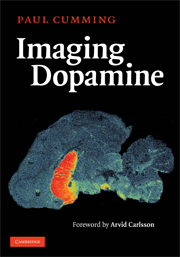Book contents
- Frontmatter
- Contents
- Foreword
- Acknowledgments
- Introduction
- 1 The life history of dopamine
- 2 Enzymology of tyrosine hydroxylase
- 3 The assay of tyrosine hydroxylase
- 4 Enzymology of aromatic amino acid decarboxylase
- 5 PET studies of DOPA utilization
- 6 Conjugation and sulfonation of dopamine and its metabolites
- 7 Dopamine synthesis and metabolism rates
- 8 MAO activity in the brain
- 9 Vesicular storage of dopamine
- 10 Dopamine release: from vesicles to behavior
- 11 The plasma membrane dopamine transporter
- 12 Dopamine receptors
- 13 Imaging dopamine D1 receptors
- 14 Imaging dopamine D2 receptors
- 15 Factors influencing D2 binding in living brain
- 16 The absolute abundance of dopamine receptors in the brain
- 17 Conclusions and perspectives
- References
- Index
- Plate section
- Frontmatter
- Contents
- Foreword
- Acknowledgments
- Introduction
- 1 The life history of dopamine
- 2 Enzymology of tyrosine hydroxylase
- 3 The assay of tyrosine hydroxylase
- 4 Enzymology of aromatic amino acid decarboxylase
- 5 PET studies of DOPA utilization
- 6 Conjugation and sulfonation of dopamine and its metabolites
- 7 Dopamine synthesis and metabolism rates
- 8 MAO activity in the brain
- 9 Vesicular storage of dopamine
- 10 Dopamine release: from vesicles to behavior
- 11 The plasma membrane dopamine transporter
- 12 Dopamine receptors
- 13 Imaging dopamine D1 receptors
- 14 Imaging dopamine D2 receptors
- 15 Factors influencing D2 binding in living brain
- 16 The absolute abundance of dopamine receptors in the brain
- 17 Conclusions and perspectives
- References
- Index
- Plate section
Summary
This book is a biography of dopamine, as illuminated by classical neurochemical methods and especially by molecular imaging with positron emission tomography (PET), or single photon emission tomography (SPET), a closely related technology.
Since the early 1980s, molecular imaging has become indispensable for the study of normal physiology, disease processes, and novel therapeutics. Using external detection with PET or SPET, the uptake and metabolism or binding of radioligands is monitored and quantified in living brain. This book summarizes the state of knowledge of the half-dozen molecular targets in the dopamine system, which have been investigated by imaging techniques. A key advantage of molecular imaging is that aspects of the life of dopamine can be studied in living brain, both in preclinical studies and in humans afflicted with neurodegenerative or psychiatric disorders in which dopamine is implicated. A key disadvantage is presented by the type of knowledge obtained by molecular imaging, which can be only indirectly informative of the step of the pathway for dopamine neurotransmission under investigation. Thus, the interpretation of molecular imaging results must always be grounded in basic aspects of the biochemistry of dopamine and the pharmacology of its binding sites.
Although several groups of dopamine neurons are found in the brain, the entire emphasis here is to be placed on the mesencephalic dopamine systems, which innervate the extended striatum and specific limbic structures of the forebrain.
- Type
- Chapter
- Information
- Imaging Dopamine , pp. 1 - 4Publisher: Cambridge University PressPrint publication year: 2009



